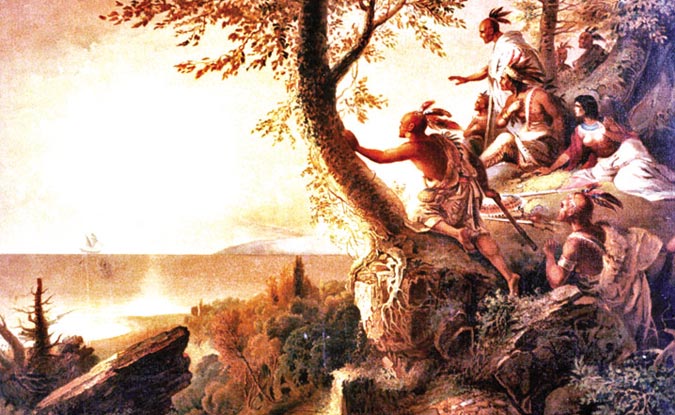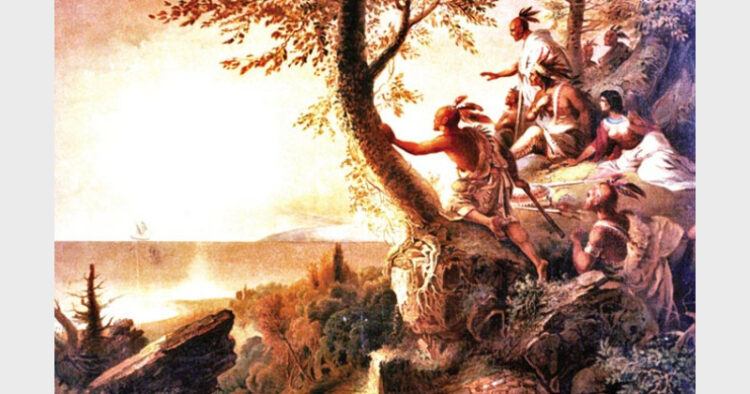Wherever Church entered with the colonial expansionists, it led organised massacres of aboriginals and pushed them away from their safe dwellings

A group of Native Americans look at a sailing ship in the bay below them. Credit Corbis, Getty
Serra landed in San Diego, California in 1769 on a mission from Spain, to commence construction on the first of 21 Catholic missions in the State. Through his directive, the Spaniards built the missions throughout California, plundering the land of its indigenous people and killing thousands of them. By 1900, 131 years after Serra”s arrival, almost 95 per cent of California”s indigenous population had been decimated — down to 16,000 people from over 300,000.
Almost a century later in 2015, Pope Francis made Junipero Serra a saint. In the same year, Pope also apologised for crimes committed against the native peoples during the so-called conquest of America. However, revering someone as a Saint who engineered the mass persecution of thousands of indigenous people, the heart of the Church seems to be not in the right place.
The whole conception of indigenous/ natives/ aboriginals and tribals as it developed in the West, was articulated with the belief that they were forced to run away in the deep forests of the country after conquerors and colonisers took over the mainland. They were identified as the inheritors and practitioners of unique cultures and ways relating to other people and the environment. Here, the Church comes in! Church played as the comrade-in-arms with the Western colonisers to manufacture the consent of modernity.
‘White Man’s Religion’
Africa serves as a prominent example of the oppressive designs of Church. Even though many biblical fables are located in modern Africa, the identification of Christianity with Europe and not Africa was propagated by white European scholars in modernity. After all, how could European colonists find a biblical reason to enslave a “dark continent” that was “uncivilised” if Christianity’s true developmental, doctrinal, and theological history was revealed to be out of Africa? Europe’s manifest destiny relied on the exploitation of Africa (ns) was concealed as “civilising.” In The History and Heritage of African American Churches: A Way out of No Way, Dr LH Whelchel contends, “thus, Africans, the historical parents of Christianity, now become the children.”
Similarly, in Australia, indigenous Australians have occupied the Australian continent for at least 40,000–60,000 years, over 2000 generations. Archaeological evidence indicates that Aboriginal people came from South-East Asia during the last ice age. At the time of first British contact, it is estimated that the Indigenous population was about 7,50,000 separated into around 500 demarcated social groupings with over 200 distinct languages with multiple dialects. However, most of these cultural diversities were lost under the oppressive designs of colonisers and church.
In America, from the time Europeans arrived on American shores, the frontier—the edge territory between white man’s civilisation and the untamed natural world—became a shared space of vast, clashing differences that led the U.S. government to authorise over 1,500 wars, attacks and raids on Indians, the most of any country in the world against its indigenous people. By the close of the Indian Wars in the late 19th century, fewer than 238,000 indigenous people remained, a sharp decline from the estimated 5 million to 15 million living in North America when Christopher Columbus arrived in 1492.
Structural Violence in Bharat
In the recent years, Church and its collaborators have been successfully turning over the narrative of their abuse in Bharat. For example, according to a monitoring organisation called Open Door, “The persecution of Christians in India has risen over the past year, pushing it up a league table of countries where the practice of the faith is a high-risk activity.” The nationalists have been projected as the chief adversaries of the Church and Christians. However, there is no truth to this claim.
The anger we are witnessing against the Church in the country today is coming up as a natural reaction to the structural violence being done by the Church. Since Bharat was unlike Africa, Australia or America, due to a very subtle and strong cultural fabric running in its vein, Church failed to commit itself to confront the tribals directly.
Tribals were persecuted by the British colonisers at first. British paramountcy had to deal with a range of violent peasant and tribal movements, such as, Mizos (1810), Kols (1795 and 1831), Mundas (1889), Daflas (1875), Khasi and Garo (1829), Kacharis (1839), Santhals (1853), Muria Gonds (1886), Nagas (1844 and 1879), Bhuiyas (1868) and Kondhas (1817) among many others. There were mass persecutions in every such rebellion, and British cannons and gunpowder also had to take a toll from bows and arrows of the forest dwellers.
The huge causalities on the part of the British army led to the formulation of plan-B. The Church missions were pushed in the forest among the tribals to win over them, disguising them for their welfare. The missionaries tried to forge unity with the tribals and in the due process started converting them to their faith and devoiced their cultural identity.
Christians associated with the Gossner Lutheran Mission and the Roman Catholic Church were involved in the Jharkhand movement from its inception. The German Gossner mission had been established in the late nineteenth century by the Catholic priest-turned-Protestant (Lutheran) John Evangelist Gossner (1773-1858). In 1841 he sent a missionary party of six to work among Gond tribals in the region, but four of them died relatively quickly. In 1844 the Gossner mission sent four more missionaries to work among the Kols (another tribals group) in what is today Bihar. Eventually, they established a lasting station at Ranchi (today the capital of Jharkhand).
The tribals peasants (Gonds, Kols, Oraons, Mundas, Santhals) in the region were cruelly oppressed by their generally upper-caste landlords (zamindars), who appeared to be in league with the judges – also upper caste – which prevented the peasants from seeking legal redress. Though there were few converts initially, when the legal work of the missionaries on behalf of the dispossessed tribals became more widely known, large numbers of tribals began to convert. The first was converted in 1850, and by 1857 (at the time of the War of Independence) there were already 900 Christians on the mission.
Thus, in Bharat, the oppressive designs of the Church worked itself up in structural ways. In the name of the welfare of tribals, they converted them and erased their unique culture.













Comments